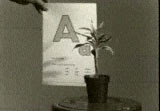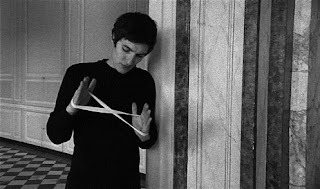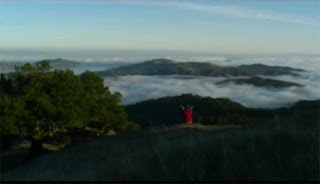But in sifting memories, notes, postcards and brochures, something emerged. This was a good year for video. (and film. Video and film. I lump it all together: art video, super-8, 16mm, the big screen, the tiny screen—moving picture art.)
In the Spring SFMOMA put on In Collaboration: Early Works from the Media Arts Collection. SFMOMA can pride itself as a leading institution in regards to video and its new curator of Media Arts, Rudolf Frieling, trotted out 30-year-old gems from the collection including my personal favorite, Transformer by Katharina Sieverding which is actually a multiple slide projection, but hey, the image appears to move. (I wrote about my love of her work here, so I won't go on about it but it was the highlight.) Also on view was a work by Nancy Holt and Robert Smithson, a walk in the park as it were, which I liked, and a Joan Jonas and Vito Acconci, among other things. It was altogether a good show.
As part of the exhibition, Frieling did a screening of funny/not so funny 70s art films (read this), things rarely seen.


John Baldessari, Teaching a Plant the Alphabet, 1972, 18 min (which can seem forever when teaching a plant).
Meanwhile, across the bay, a recent work by Joan Jonas was at the Berkeley Art Museum. The Shape, the Scent, the Feel of Things (2004-05) is a multimedia installation which incorporates footage of a live performance which itself includes actors, objects, music, multiple video and audio layers. It is at once rough and clumsy, and poetic, lyrical, beautiful. This was by far one of the most resonant works—resonant in a dream-like way—that I saw all year.

Coyote watching the unfolding drama. Coyote "floating' through the landscape.
Also in the Spring there was California Video at the Getty. It was an overload—an incredible array of video art. From the early days: Bruce Nauman!—Target Video Punk Performances—Alan Ackroff, Cornceptual Art (Art all the time when you have a conceptual mind)—Paul McCarthy, Stomach of the Squirrel, to recent big complex works: Jim Campbell, Home Movies—Bill Viola—Lynn Marie Kirby—Diana Thater, to name a few—what I mean by overload.
The great Bill Viola who is clearly at the head of his class was represented by two older works in the show and another, Emergence, in another part of the museum. This stunning slow motion, undulating, unfolding, timeless scene plays out the rebirth of a man from a (watery) grave mid-wived by two women at first sorrowful, then astonished. Besides the christian-Renaissance inflected content, this piece demonstrates exactly how far video art has come.

Video art is a challenge to present especially when there is more than one piece. At the Getty it was dark rooms filled with buzzing screens. The first hall had station after station of monitors (or vintage TVs) with earphones and little benches. The second space held larger works in small rooms, or simultaneously projected upon adjacent walls. The best though, was in between: the video study room lined with benches and touch computer screens showing the entire assortment of works. 62 pieces were included in the show plus extras shown in screenings inside and out in the garden. All too good, but too far away to see it all.
The Puppet Show at the Santa Monica Museum (which I wrote about here) included some great video art in it's survey of art-puppets and puppet-art. The clever curators there built video booths out of plywood. This worked nicely, little video stations.
Later in the Spring, CCA Wattis Institute for Contemporary Arts hosted the wonderful set-piece 8 by Ulla von Brandenberg as part of their series Passengers.

The eighth show of the series, 8 is 16-mm film, black and white, and silent, that runs for 9 minutes during which time the camera roves in a single tracking shot through rooms of a 17th century castle. Each room is a dreamlike tableaux of contemporary person(s), furniture, and objects, posed and static. Riveting and beautiful, the film, beginning where it ends, traverses the rooms and encounters a woman looking out a window, a sleeping man, a dead man and mourners, a cane leaning on a wall. Von Brandenberg is working here with theatrical tension, creating an emotional vocabulary which plays, scene by scene, over and over again.
[Reader, please note how often I've used the word Spring. This all happened in the Spring like someone said Video is the new Spring fashion.]
Altogether now, In the Spring...
In February, Pacific Film Archive screened James Bennings' silent 16 mm film casting a glance.

Over the course of 80 minutes and broken into 16 parts, like chapters, this landscape film, moving/barely moving, tracks Robert Smithson's earth work Spiral Jetty through seasons and years of change. It is not so much a glance as a visitation, certainly an homage, almost like being there.
Summer & Fall

A video of a different color (pink), Soft Sculpture Sunset, by Takehito Koganezawa both mesmerized and irritated me. It stands as a highlight of the year, seeing as how I can still bring it to mind, the two pair of hands, pink, yellow, white latex clad, squeezing and molding clay while a curtain waves and waggles in the breeze... well you gotta see it. Which you can here on the Christopher Grimes Gallery website. It is 5 minutes long and silent.
Astral Fields/Antepartum the video installation of face-to-face videos by mother and son Mary Kelly and Kelly Barrie shown as part of the CA Biennial at Queen's Nails Projects is a project that bridges many things, early art film and digital video being the most mundane connection. I enthused about it here.
The video art that wins my 2008 cakewalk is (drum roll) the set of videos by Richard T. Walker shown this Fall at that consistently interesting gallery, David Cunningham Projects, SF. I've tried to come to terms with—find the right words for—these works which traverse a literary territory so out of the ordinary, certainly out of the American contemporary, that I'm not sure I can do it now, even after discussing the very thing with Walker himself. Perhaps I could just be plainspoken. Or perhaps I can let someone else speak.
Here. Read this by Tom Keogh:
He combines a Woody Allenesque obsession regarding the complex language of relational psychology with images of breathtakingly beautiful landscapes and buccolic scenes. Art, personal relations as we try to understand them, and complex (often kitsch) notions of beauty and the sublime merge seamlessly in his work to create thoughtful and affecting ruminations on the fickle nature of the human emotional and cognitive processes. The direct, seemingly naive, gaze and the presence of the artist himself in many of the pieces allows the viewer a direct connection with these concerns as we stare out into the void, not of sublime transcendence, but of the failed connections and broken promises of a world created to help us rediscover our happiness.
I couldn't have said it better myself.
Well, alright, I wouldn't have put in the last bit—I'm not sure if the world was created to help us rediscover our happiness, whatever that means, but for sure happiness and the longing for it through relationship is one of the matters on which Walker ruminates.

tamed through the sculpture of past experience: letters from a valley to a mountain and from a mountain to a valley. 2008, digital video, 9 min 26 sec.
Dialog, at turns witty, but always going a narrow path between ironic (which would be insincere) and sentimental (which would be something other than sincere as well), is the vehicle here that makes these works un-American, and I say this fondly. Walker's ear for inner dialog, for the twists and turns of relational exchange, for the subtleties of literary and social conventions is so sharp that it is natural. (But far too literate and philosophical to be American.) That the words are spoken, as it were, by a valley to mountain, or about the feelings a tree might have about, say, a taller tree, well, that takes us into other territory altogether. (Yes, a pun.) The territory of which I speak is the land, or rightly written the Land. Land and the relationship to Land (the concept) and land (the place) is a central theme. All these notions lie in the background, behind our eyes, as we gaze out on the view. Land, landscape, nature, the ground of being and the idea of Natural, Eden, Paradise Lost (perhaps that is the created world Keogh refers to, the created map of Paradise for which there is no ground.) There's such a complex web of associations and inferences, projection and anthropomorphizing, through which we hope to have an experience of—for lack of better word—nature. And with a song or simple gesture—a wave—Walker cuts right through to the heart of the matter.

A favorite moment: applauding the landscape in outside the democracy of circumstance, 2008, digital video, 6 min 44 sec.
There is much more to be said, much more to be learned from these slight yet penetrating works. Like slim volumes on a shelf, I want to go back, again and again, to dip into and delight in the words and the grand view.
So Richard T. Walker takes the cake.
It was after all a good year. I saw video (which I love) like I haven't seen video before (lots) but I have to confess my one miss was somehow entirely missing out on seeing the West Coast Premiere of The Rape of the Sabine Women, the video musical by Eve Sussman that I anticipated with, well, not bated breath perhaps, but interest and excitement. But it was here, in San Francisco, and I could have seen it, so I add it to round out the list.
Well. That's that.
Happy New Year. May it be bright.















































